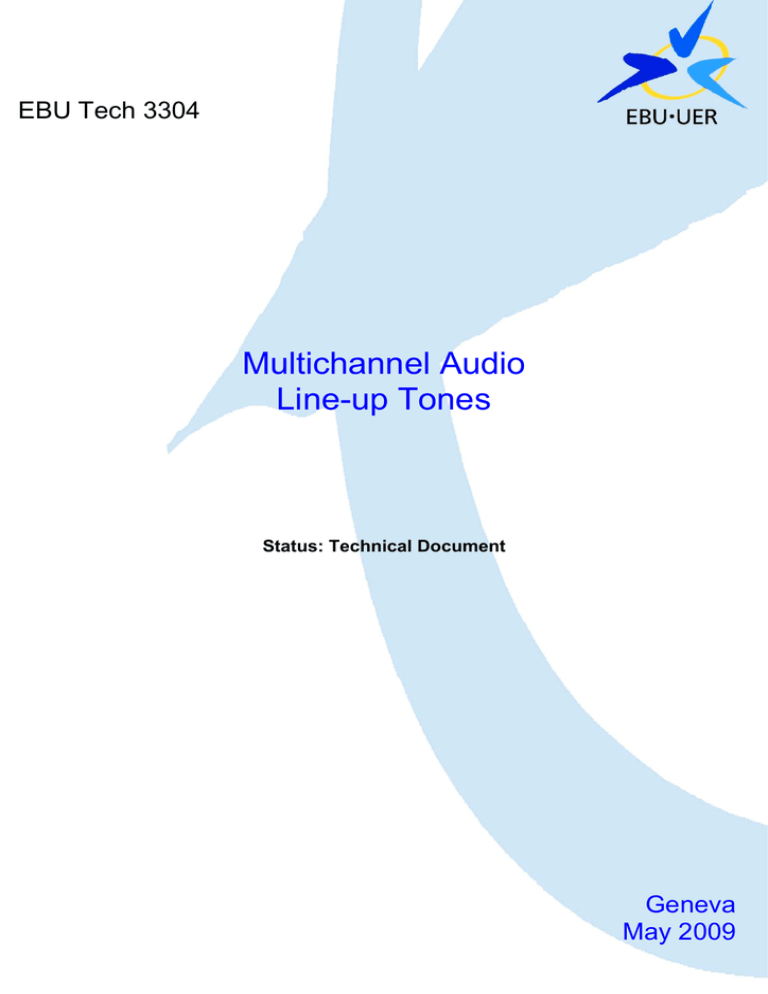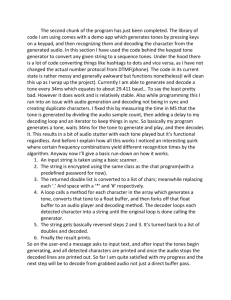Multichannel Audio Line-up Tones
advertisement

EBU Tech 3304 Multichannel Audio Line-up Tones Status: Technical Document Geneva May 2009 Tech 3304 Multichannel audio line-up tones Contents 1. Introduction.................................................................................................. 5 2. Existing line-up tone arrangements and uses ......................................................... 5 2.1 Two channel audio identification....................................................................... 5 2.2 Signal levels................................................................................................ 5 3. Requirements for a multichannel line-up and identification signal............................... 6 4. Temporal Identification of Spatial line-up signals .................................................... 6 4.1 BLITS (Black and Lanes’ Ident Tones for Surround) .................................................. 6 BLITS Frequencies ........................................................................................... 6 BLITS Signal Timings......................................................................................... 7 4.2 The EBU multichannel ident signal ..................................................................... 8 Bibliography ....................................................................................................... 9 3 Multichannel audio line-up tones Tech 3304 4 Tech 3304 Multichannel audio line-up tones Multichannel Audio line-up Tones EBU Committee First Issued Revised PMC 2005 2009 Re-issued Keywords: Multichannel Audio, Line-up tone 1. Introduction The primary uses of the alignment signal described are to identify the system and the channel allocations. In conjunction with an audio editing workstation, the described format can also provide a deeper insight into the history of received material. 2. 2.1 Existing line-up tone arrangements and uses Two channel audio identification EBU recommendation R 49-1999 [1] describes a line up tone that identifies the Left stereo, or channel 1, by means of interrupting a 1 kHz tone at the alignment level for 250 ms every 3 seconds. This interruption enables phase relationships to be audibly checked, as well as checking and identifying the monophonic mix. Left Right 1s Figure 1: Stereo Line-up Tone This “EBU line-up” format is especially prevalent, and it will continue to be used for any two channel mix which may be carried along with multichannel “bundles” Thus any multichannel lineup arrangement must be easily differentiated from the two channel EBU version without any need for special equipment or training. Another existing alternative line-up format is often used for dual languages, heading the main language track with a continuous 1kHz tone, whist the secondary language on the track is headed by a 400 Hz signal. Experience has however shown that many operational staff find identification of isolated tone frequencies difficult. 2.2 Signal levels Three different (but related) levels of line up signal are recognised internationally in ITU-R BS 645-2 [2]. They are known as "Alignment Level" (AL), " Permitted Maximum Level" (PML), and "Measurement Level" (ML). 5 Multichannel audio line-up tones Tech 3304 Alignment Level is the most enduring of these three signals, and it is the one to be found on the headers of recordings, or left connected on lines in the absence of programme. In R68-2000 [3] the EBU recommends that in digital audio equipment, its Members should use coding levels for digital audio signals which correspond to an alignment level which is 18 dB below the maximum possible coding level of the digital system, irrespective of the total number of bits available. Permitted Maximum Level on the other hand, equates to the peak modulation on a Radio link or emission. It is set at a level 8 or 9 dB higher than Alignment level, depending on the regulatory authority. Note that this nominal peak level for broadcast use is some 9 or 10 dB lower than the peak digital modulation on “finished” commercial recordings, such as CD or DVD, although transient excursions of peak signal up to 6 dB above PML may occur in practice. 3. Requirements for a multichannel line-up and identification signal Typical broadcast multichannel audio may be in the form of interleaved or related mono MBWF files, in accordance with EBU R123-2009 [4], R111-2004 [5], or maybe stereo pairs or multitrack tape tracks to EBU R91-2004 [6] or to R48-2005 [7]. Any Line-up procedure must therefore establish:• • • • 4. The presence and spatial position of all the main channels. The presence of an LFE channel if supplied. Consistent signal levels compatible with conventional programme level meters. Quantitative indication of the matrix coefficients used for stereo or mono downmixes. Temporal Identification of Spatial line-up signals 4.1 BLITS (Black and Lanes’ Ident Tones for Surround) The “BLITS” test sequence was developed by Martin Black and Keith Lane, both Senior Sound Supervisors at BSkyB in the UK. The requirement was to develop a signal that enabled the identification of all the channels in a 5.1 mix, yet was still meaningful when monitoring the stereo downmix of the 5.1 signal. A discussion of the design of the BLITS signal is to be found in [8]. The BLITS signal is now in common use amongst several European broadcasters and generators are commercially manufactured. The BLITS signal sequence is recommended for normal 5.1 channel programme headers. Figure 2 represents the BLITS sequence; note that this figure is not to scale. BLITS Frequencies The frequencies used are based on the international musical standard of A = 440 Hz and the interval of a perfect fifth above it (E). The actual frequencies used are: L = 880 Hz C = 1320 Hz Ls = 660 Hz R = 880 Hz LFE = 82.5 Hz Rs = 660 Hz 6 Tech 3304 Multichannel audio line-up tones Figure 2: BLITS 5.1 Ident (not to scale) BLITS Signal Timings The sequence is composed of three distinct sections, as follows. Section 1: 5.1 Idents section, various frequencies @ -18dBfs: Each channel is identified by a tone burst of 600ms duration, with a spacing of 200ms between tone bursts, followed by 200ms of silence. This sequence runs from 0.00s > 4.80s (i.e. duration = 4.80s). Section 2: “Stereo” ident section, 1 kHz @ -18dBfs: The right channel is a continuous tone burst of 5.1s duration. The left channel is a discontinuous tone burst. The breaks in the left channel are at 1s, for 300ms, then on-and-off for 300ms, three more times, followed by 2s of steady tone. Then silence for 300ms on both left and right channels. This sequence runs from 4.80s > 10.20s (i.e. duration = 5.40s). Section 3: Phase-check section, 2 kHz @ -24dBfs: All channels contain 3s of in-phase 2kHz tone, followed by 200ms of silence. This sequence runs from 10.20s > 13.40s (i.e. duration = 3.20s). The total duration of a complete BLITS sequence is therefore 13.40s. The sequence may repeat indefinitely. 7 Multichannel audio line-up tones 4.2 Tech 3304 The EBU multichannel ident signal The EBU multichannel 1 kHz line-up signal is recommended for systems other than 5.1, and where high downmix levels would be acceptable. The ident sequence is represented in Figure 3. Channel Identification Front Left Centre Front Right Right Surround Left Surround LFE 1s Figure 3: EBU multichannel lineup tone sequence On all the main channels, 3 seconds of 1 kHz coherent tone are followed by 0.5 s silence, then all the main channels are identified in clockwise reproduction order, starting at front left. The identification consists of an individual 0.5 s burst of 1 kHz tone spaced by a 0.5 s silence gap before the next channel in line is identified. After a final 1 s of silence the sequence repeats with three seconds of tone on all main channels. 1. The total period occupied in the identification therefore shows the total number of main channels to be expected, i.e. 6.0 s for 5.0 or 5.1 signals, 7.0 s for 6.1, and 8.0 s for 7.1 etc. 2. Any signal formed from a combination of these channels will retain the bursts at the levels used in the matrix. 3. The LFE channel carries 80 Hz continuous tone. Although the tone is recorded at line-up level, this channel is conventionally reproduced at a level 10 dB higher than the main channels (see Tech 3276 s1 [9] for channel alignment). However, the low perceived loudness of 80 Hz tone, ensures an even balance is maintained. The sequence then may repeat indefinitely. 8 Tech 3304 Multichannel audio line-up tones Bibliography [1] R49-1999 [2] ITU-R BS645-2 [3] R68-2000 [4] R123-2009 [5] R111-2004 [6] R91-2004 Tape alignment leader for the exchange of television programmes Test signals and metering to be used on international sound-programme connections Alignment level in digital audio production equipment and in digital audio recorders EBU Audio Track Allocation for File Exchange Multichannel use of the BWF audio file format (MBWF) Track allocations and recording levels for the exchange of multichannel audio signals [7] R48-2005 Allocation of audio tracks on digital television recorders BLITS Surround Sound Ident, Martin Black MIBS – Feb/Mar 2007 Issue of [8] IBS Journal Line UP Magazine [9] Tech 3276 suppl.1 Listening conditions for the assessment of sound programme material: multichannel sound 9


